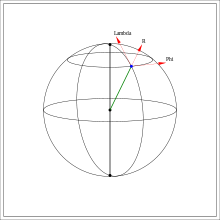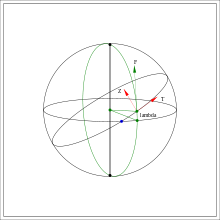Frozen orbit
In orbital mechanics, a frozen orbit is an orbit for an artificial satellite in which natural drifting due to the central body's shape has been minimized by careful selection of the orbital parameters. Typically this is an orbit where, over a long period of time, the altitude remains constant at the same point in each orbit[1]—changes in the inclination, position of the lowest point of the orbit, and eccentricity have been minimized by choosing initial values so that their perturbations cancel out.[2] This results in a long-term stable orbit that minimizes the use of stationkeeping propellant.
Background and motivation
For many spacecraft, changes to orbits are caused by the oblateness of the Earth, gravitational attraction from the Sun and Moon, solar radiation pressure, and air drag. These are called "perturbing forces". They must be counteracted by maneuvers to keep the spacecraft in the desired orbit. For a geostationary spacecraft, correction maneuvers on the order of 40–50 m/s per year are required to counteract these forces.
For Sun-synchronous spacecraft, intentional shifting of the orbit plane (called "precession") can be used for the benefit of the mission. For these missions, a near-circular orbit with an altitude of 600–900 km is used. An appropriate inclination (97.8-99.0 degrees) is selected so that the precession of the orbital plane is equal to the rate of movement of the Earth around the Sun - or about 1 degree per day.
As a result, the spacecraft will pass over points on the Earth that have the same time of day during every orbit. For instance, if the orbit is "square to the Sun", the vehicle will always pass over points at which it is 6 a.m. on the north-bound portion, and 6 p.m. on the south-bound portion. This is called a "Dawn-Dusk" orbit. Alternatively, if the orbit plane is perpendicular to the Sun, the vehicle will always pass over Earth noon on the north-bound leg, and Earth midnight on the south-bound leg. These are called "Noon-Midnight" orbits. Such orbits are desirable for many Earth observation missions such as weather, imagery, and mapping.
Perturbing forces caused by the oblateness of the Earth will also change the shape (called the "eccentricity") of the orbit. To compensate, there are near-circular orbits where there are no secular/long periodic perturbations of the eccentricity, only periodic perturbations with the same period as the orbit. Such an orbit is called a "frozen orbit". These orbits are often the preferred choice for Earth observation missions where repeated observations under constant conditions are desirable.
The Earth observation satellites ERS-1, ERS-2 and Envisat are operated in Sun-synchronous frozen orbits.
Classical theory
The classical theory of frozen orbits is essentially based on the analytical perturbation analysis for artificial satellites of Dirk Brouwer made under contract with NASA and published in 1959.[3]
This analysis can be carried out as follows:
In the article Orbital perturbation analysis (spacecraft) the secular perturbation of the orbital pole from the term is shown to be
|
(1) |
which can be expressed in terms of orbital elements thusly:
|
(2) |
|
(3) |
Making the analogue analysis for the term, one gets
|
(4) |
which can be expressed in terms of orbital elements as
|
(5) |
|
(6) |
In the same article the secular perturbation of the components of the eccentricity vector caused by the is shown to be:
|
(7) |
where:
- The first term is the in-plane perturbation of the eccentricity vector caused by the in-plane component of the perturbing force
- The second term is the effect of the new position of the ascending node in the new orbital plane, the orbital plane being perturbed by the out-of-plane force component
Making the analogue analysis for the term one gets for the first term, i.e. for the perturbation of the eccentricity vector from the in-plane force component
|
(8) |
For inclinations in the range 97.8–99.0 deg, the value given by (6) is much smaller than the value given by (3) and can be ignored. Similarly the quadratic terms of the eccentricity vector components in (8) can be ignored for almost circular orbits, i.e. (8) can be approximated with
|
(9) |
Adding the contribution
to (7) one gets
|
(10) |
Now, the difference equation shows that the eccentricity vector will describe a circle centered at the point ; the polar argument of the eccentricity vector increases with radians between consecutive orbits.
As
one gets for a polar orbit () with with the circle centered at and the change of polar argument is 0.00400 radians per orbit.
The latter figure means that the eccentricity vector will have described a full circle in 1569 orbits. Selecting the initial mean eccentricity vector as the mean eccentricity vector will stay constant for successive orbits, i.e. the orbit is frozen because the secular perturbations of the term given by (7) and of the term given by (9) cancel out.
In terms of classical orbital elements, this means that a frozen orbit should have the following (mean!) elements:
Modern theory
The modern theory of frozen orbits is based on the algorithm given in.[4]
For this the analytical expression (7) is used to iteratively update the initial (mean) eccentricity vector to obtain that the (mean) eccentricity vector several orbits later computed by the precise numerical propagation takes precisely the same value. In this way the secular perturbation of the eccentricity vector caused by the term is used to counteract all secular perturbations, not only those (dominating) caused by the term. One such additional secular perturbation that in this way can be compensated for is the one caused by the solar radiation pressure, this perturbation is discussed in the article "Orbital perturbation analysis (spacecraft)".
Applying this algorithm for the case discussed above, i.e. a polar orbit () with ignoring all other perturbing forces then the and the forces for the numerical propagation one gets exactly the same optimal average eccentricity vector as with the "classical theory", i.e. .
Including also the forces due to the higher zonal terms the optimal value changes to .
Assuming in addition a reasonable solar pressure (a "cross-sectional-area" of 0.05 square meters per kg, the direction to the Sun in the direction towards the ascending node) the optimal value for the average eccentricity vector gets what corresponds to :, i.e. the optimal value is no more
This algorithm is implemented in the orbit control software used for the Earth observation satellites ERS-1, ERS-2 and Envisat
Derivation of the closed form expressions for the J3 perturbation
The main perturbing force to be counter-acted to have a frozen orbit is the " force", i.e. the gravitational force caused by an imperfect symmetry north/south of the Earth, and the "classical theory" is based on the closed form expression for this " perturbation". With the "modern theory" this explicit closed form expression is not directly used but it is certainly still worthwhile to derive it.
The derivation of this expression can be done as follows:
The potential from a zonal term is rotational symmetric around the polar axis of the Earth and corresponding force is entirely in a longitudial plane with one component in the radial direction and one component with the unit vector orthogonal to the radial direction towards north. These directions and are illustrated in Figure 1.

In the article Geopotential model it is shown that these force components caused by the term are
|
(11) |
To be able to apply relations derived in the article Orbital perturbation analysis (spacecraft) the force component must be split into two orthogonal components and as illustrated in figure 2

Let make up a rectangular coordinate system with origin in the center of the Earth (in the center of the Reference ellipsoid) such that points in the direction north and such that are in the equatorial plane of the Earth with pointing towards the ascending node, i.e. towards the blue point of Figure 2.
The components of the unit vectors
making up the local coordinate system (of which are illustrated in figure 2), and expressing their relation with , are as follows:
where is the polar argument of relative the orthogonal unit vectors and in the orbital plane
Firstly
where is the angle between the equator plane and (between the green points of figure 2) and from equation (12) of the article Geopotential model one therefore obtains
|
(12) |
Secondly the projection of direction north, , on the plane spanned by is
and this projection is
where is the unit vector orthogonal to the radial direction towards north illustrated in figure 1.
From equation (11) we see that
and therefore:
|
(13) |
|
(14) |
In the article Orbital perturbation analysis (spacecraft) it is further shown that the secular perturbation of the orbital pole is
|
(15) |
Introducing the expression for of (14) in (15) one gets
|
(16) |
The fraction is
where
are the components of the eccentricity vector in the coordinate system.
As all integrals of type
are zero if not both and are even, we see that
|
(17) |
and
|
(18) |
It follows that
|
(19) |
where
- and are the base vectors of the rectangular coordinate system in the plane of the reference Kepler orbit with in the equatorial plane towards the ascending node and is the polar argument relative this equatorial coordinate system
- is the force component (per unit mass) in the direction of the orbit pole
In the article Orbital perturbation analysis (spacecraft) it is shown that the secular perturbation of the eccentricity vector is
|
(20) |
where
- is the usual local coordinate system with unit vector directed away from the Earth
- - the velocity component in direction
- - the velocity component in direction
Introducing the expression for of (12) and (13) in (20) one gets
|
(21) |
Using that
the integral above can be split in 8 terms:
|
(22) |
Given that
we obtain
and that all integrals of type
are zero if not both and are even:
Term 1
|
(23) |
Term 2
|
(24) |
Term 3
|
(25) |
Term 4
|
(26) |
Term 5
|
(27) |
Term 6
|
(28) |
Term 7
|
(29) |
Term 8
|
(30) |
As
|
(31) |
It follows that
|
(32) |
References
- ↑ Eagle, C. David. "Frozen Orbit Design" (PDF). Orbital Mechanics with Numerit. Retrieved 5 April 2012.
- ↑ Chobotov, Vladimir A (2002). Orbital Mechanics (3rd Edition). American Institute of Aeronautics and Astronautics. p. 221.
- ↑ Dirk Brouwer: "Solution of the Problem of the Artificial Satellite Without Drag", Astronomical Journal, 64 (1959)
- ↑ Mats Rosengren: "Improved technique for Passive Eccentricity Control (AAS 89-155)", Vol. 69, Advances in the Astronautical Sciences